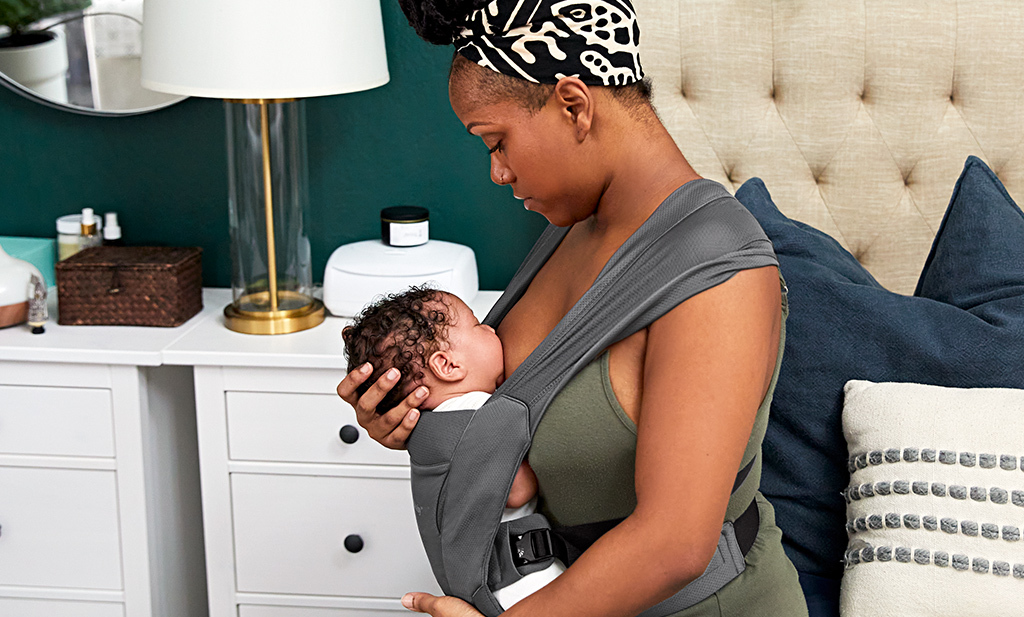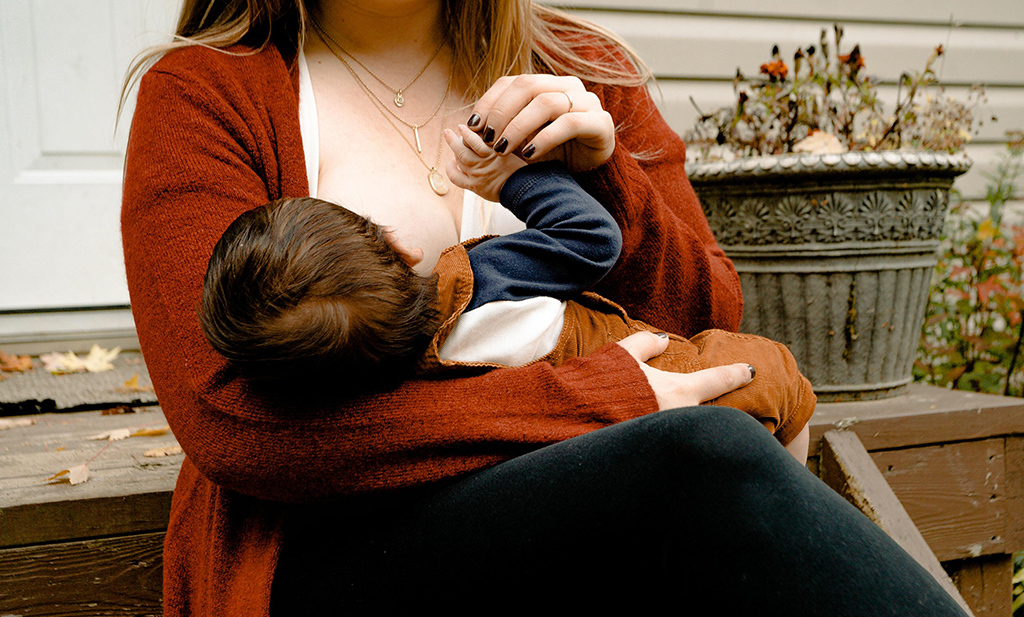
If you’ve just started out breast/chest feeding, you might be seeking guidance on how to gauge your baby’s milk intake, understand the causes of low milk production, and learn effective methods to increase milk supply. This is a common concern for breast/chest feeding mums. After all, your breasts/chest don’t have a full/empty gauge, so how do you know how much is coming out?
Luckily, there’s usually no need to worry about this: Breast/chest fed babies usually take as much milk as they need at each feed, and under normal conditions your breasts/chest will automatically produce less or more breast milk in response to that demand.
So how can you tell if that’s happening? If you’re ever in doubt, your postpartum midwife or a lactation consultant (IBCLC) can give you specific help you on your breast/chest feeding journey.
In this blog, our midwife Katrin Ritter tells you what you can do if you don’t have enough milk. So, read on to discover the 10 best tips to boost your milk flow.
How breast/chest milk supply works.
Once your breast/chest milk has come in, your breasts/chest start to make milk through a process of ‘supply and demand’. Each time milk is removed, either by your baby feeding or by expressing, your breasts make more.
That’s why giving bottles of formula can reduce your milk supply – your body isn’t getting the message to produce more breast/chest milk, because none is being removed.
The way your baby nurses also affects your supply. The more frequently and effectively your baby breastfeeds, the more milk you’ll make. If your baby doesn’t take enough milk during a feed, it’s essential to express regularly to protect your milk supply.
What prevents milk production and how can you encourage milk flow?
1. Breast/chest feeding baby often.
Frequent breast/chest feeding promotes the flow of milk. However, some babies are such sleepyheads in the first few weeks that they don’t even wake up to feed their hunger. This can lead to your baby not gaining enough weight and your milk flow not being stimulated. That’s why it’s a good idea to wake your baby at least every two hours to feed.
In the first few weeks’ newborn babies may feed 8 to 12 times a day or more, with feeds getting longer and farther apart as time goes by. Of course, you can always breast/chest feed more often if your baby feels the need.
Handy tip: Always breast/chest feed both breasts for at least 10 -15 minutes.
As a sign of sufficient breast milk consumption, your baby should have/show the following:
– From day 3 (until approx. 4 – 6 weeks after birth) at least 3 bowel movements in 24 hours.
– From day 4 after birth at least 4 – 6 wet nappies in 24 hours.
– Noticeable swallowing at the onset of the milk-giving reflex.
– Birth weight regained after 10 -14 days.
– Gained approx. 170-330g per week in the first 2 months.
– Doubled birth weight after 3 – 4.5 months.
– Gained 110-330g per week in the 3rd and 4th month.
– Baby is alert, with good muscle tone and smooth skin.
– Your breasts/chest should feel softer after breast/chest feeding.
(Source: European Institute for Breastfeeding and Lactation)
2. Stimulate milk production: Expressing helps.
Demand determines supply. This means that when your breasts/chest notice that a lot of milk is needed, they produce more fresh milk. You can support this with the help of a breast pump if your baby needs a little support in the early days. An electric breast pump is ideal because it does the work for you. You don’t have to buy one, you can often borrow or rent one. Pumping a little on each side after each breast/chest feeding session can quickly boost milk production.
Tips when pumping: Sit down in a relaxed position and stay calm and comfortable. Some mothers find it helpful to nurse with one breast/chest and pump at the other. There are also wearable breast pumps that you can put directly into your bra. See what works for you. If you feel that you are not getting any milk when you pump, talk to your midwife or lactation consultant. It could be that your breast/chest attachment is the wrong size.
3. Sleep and breast/chest feeding.
Breastfeeding and sleep often overlap in the early weeks, when your baby spends more time asleep than awake. Dozing off mid-feed and waking for more milk a short time later is normal for newborns.
You can carry on breast/chest feeding your baby to sleep, and feed them back to sleep during the night, for as long as you’re happy to. Many mums find that breast/chest feeding to sleep, especially at night, is a lovely way to get close to their baby and have some uninterrupted time together.
As your baby gets older and feeds less often, you may decide to stop feeding your baby to sleep so they can get used to settling themself. Some parents find that if their baby feeds until they sleep, they start to link the two. That can make things more difficult if you start trying to cut down on night feeds or if you’re getting into a bedtime routine.
Source: Baby Centre. https://www.babycentre.co.uk/a553835/sleep-and-breastfeeding
4. Help baby stay awake when feeding.
As baby gets older, if you want to keep them awake when feeding you can undress them down to the nappy before breast/chest feeding (please ensure a warm environment and keep an eye on baby’s temperature – not for newborns as they cool down too quickly), tickle their feet or even hold them upright when you change breasts. This will help to stay awake and ensure that enough milk is drunk so that your milk production eventually kicks into high gear and, of course, your little one grows big and strong.

5. Skin to skin bonding.
When cuddling – especially when touching skin to skin – our bonding hormone oxytocin is released. This is great for mother and child bonding, and bonus, boosts milk production.
Top tip: Cuddle and babywear as often as possible. Free your upper body and undress your baby. A baby carrier from birth onwards can relieve the strain.
6. Ask for help from your midwife or lactation consultant.
All beginnings are difficult and worrying and may even lead to stress. The production of stress hormones like cortisol can block the flow of milk. Stress puts your body into fight-or-flight mode, and it will then reduce all functions that are not vital for your survival. This includes the activity of the mammary glands.
Remember help is at hand either through your midwife or a lactation consultant.
You can talk about different breast/chest feeding techniques that make your journey easier for you and your baby. An ergonomic breastfeeding pillow like our Natural Curve Nursing Pillow can help you to physically relax. Your baby automatically lies in the right position, secured against rolling down and back pain for you is avoided due to the optimal height.
7. Maintain a healthy diet.
You will consume more energy and micronutrients while breast/chest feeding. Eat a balanced diet and to listen to your hunger pangs. Avoid nutritional deficits, immediately after giving birth. In the long run, malnutrition can also have a negative effect on milk production. Apart from the fact that you might run out of energy.
You don’t need to eat anything special while you are breast/chest feeding. But it’s a good idea for you, just like everyone else, to eat a healthy diet.
The NHS suggest a healthy diet to include:
- At least 5 portions of a variety of fruit and vegetables a day, including fresh, frozen, tinned and dried fruit and vegetables.
- No more than one 150ml glass of 100% unsweetened juice.
- Starchy foods, such as wholemeal bread, pasta, rice, and potatoes.
- Plenty of fibre from wholemeal bread and pasta, breakfast cereals, rice, beans and lentils, and fruit and vegetables – after having a baby, some women have bowel problems and constipation, and fibre helps with both.
- Protein, such as lean meat and chicken, fish, eggs, nuts, seeds, soya foods – no more than 2 portions of fish a week is recommended, including 1 portion of oily fish.
- Dairy foods, such as milk, cheese, and yoghurt – these contain calcium and are a source of protein.
- Non-dairy sources of calcium suitable for vegans include tofu, brown bread, and dried fruit.
- Drink plenty of fluids – have a drink beside you when you settle down to breast/chest feed: water and skimmed or semi-skimmed milk are all good choices.
8. Apply a warm cloth to your breast/chest to loosen engorged milk ducts and promote milk flow.
Use a warm, not hot cloth on your breasts/chest before breast/chest feeding. We do not recommend using a hot water bottle. You may sweat due to your hormones, and we want to avoid the risk of burns. You can read more about how to avoid breasts/chest feeding problems here.
9. Try to avoid using a dummy.
To avoid sucking confusion in the first few weeks, try not to give your baby a dummy. Only use a dummy to sooth and calm your baby when your breast/chest feeding relationship is going well and you have enough milk supply. And even then: always give the dummy after breast/chest feeding.
10. Increasing Milk Supply – use of Galactagogues.
According to Breastfeeding network, Galactagogues are substances that aid the initiation and maintenance of milk supply at a level which meets the needs of the baby. The production of milk is controlled by the hormone prolactin. Nipple stimulation controls the release of prolactin whilst oxytocin controls the release of the milk, experienced as the letdown. But be careful: The causes of low milk production should be clarified beforehand and these drugs should never be used on their own. They have not yet been sufficiently investigated in studies, so that treatment should always be carried out by experts and medicinal galactagogues should always be critically examined for their effectiveness and possible side effects. .
Encouraging milk flow – there are so many options.
We hope that this blog has given you some tips on how to increase your milk supply, and that you know the various options to try as you start your breast/chest feeding journey with your little bundle of joy.



